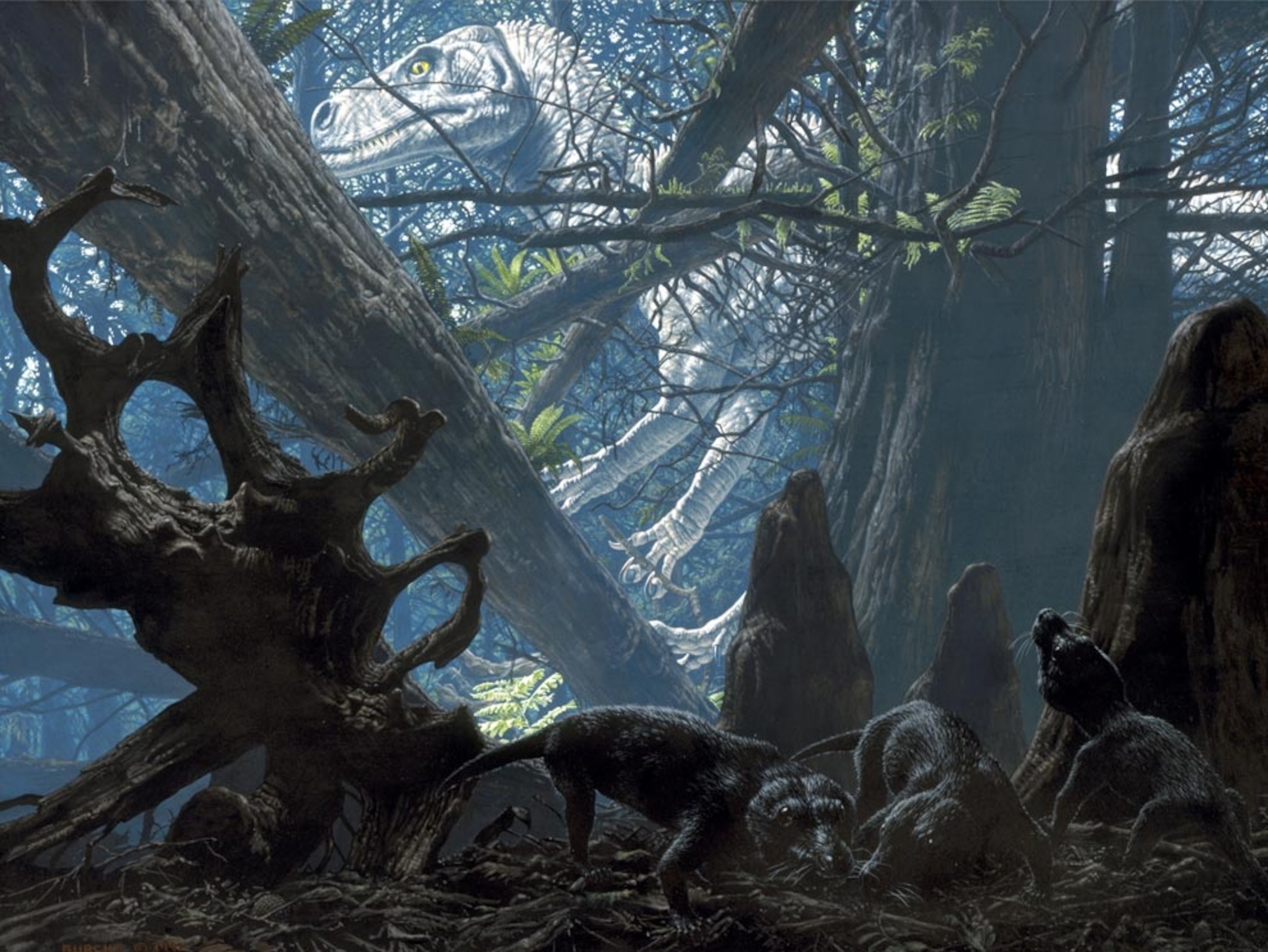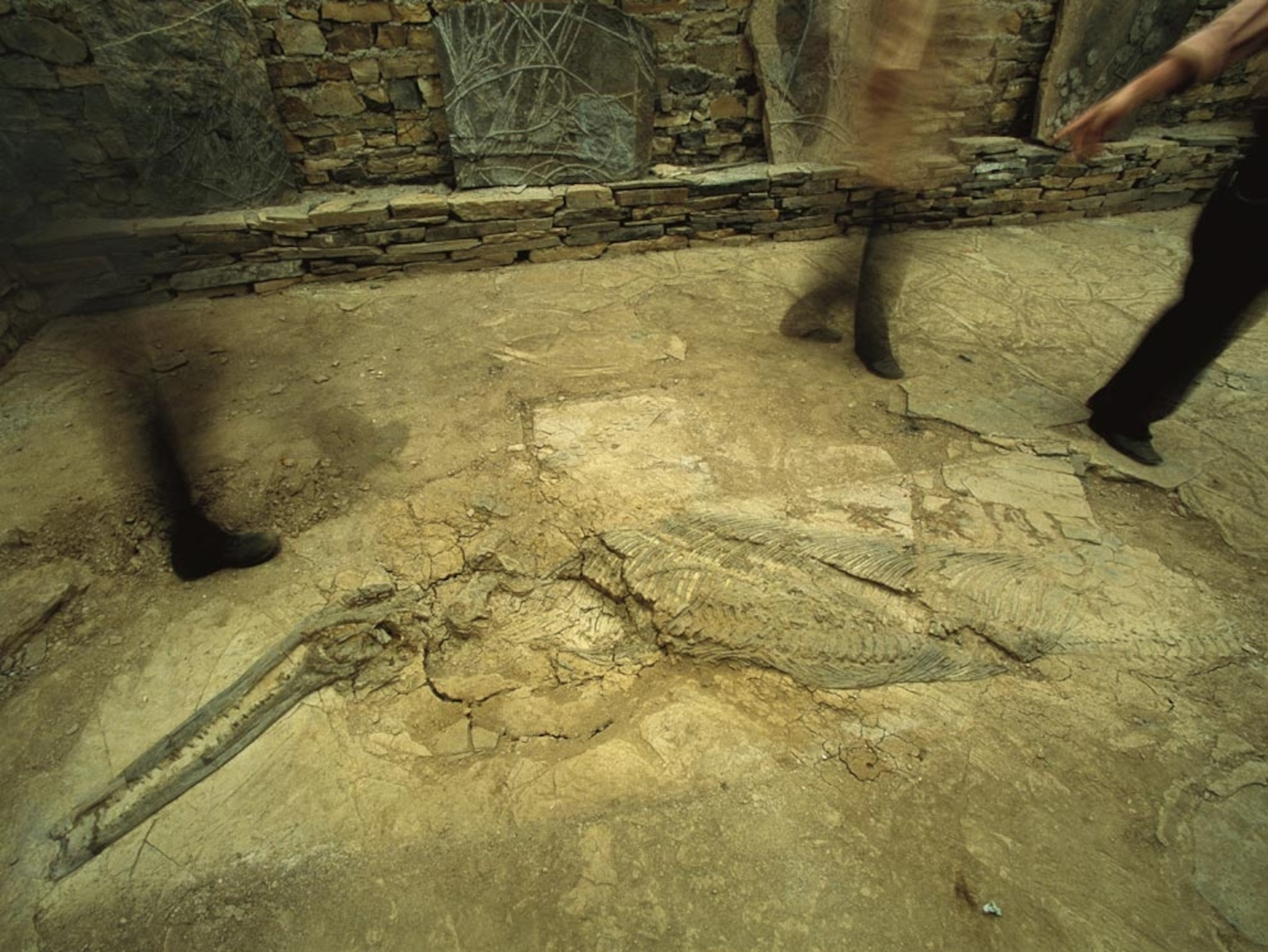The start of the Triassic period (and the Mesozoic era) was a desolate time in Earth's history. Something—a bout of violent volcanic eruptions, climate change, or perhaps a fatal run-in with a comet or asteroid—had triggered the extinction of more than 90 percent of Earth's species.
But it was also a time of tremendous change and rejuvenation. Life that survived the so-called Great Dying repopulated the planet, diversified into freshly exposed ecological niches, and gave rise to new creatures, including rodent-size mammals and the first dinosaurs.
Pangaea
By the start of the Triassic, all the Earth's landmasses had coalesced to form Pangaea, a supercontinent shaped like a giant C that straddled the Equator and extended toward the Poles. Almost as soon as the supercontinent formed, it started to come undone. By the end of the period 199 million years ago, tectonic forces had slowly begun to split the supercontinent in two: Laurasia in the north and Gondwana in the south.
The giant ocean called Panthalassa surrounded Pangaea. Areas near the coast were pummeled by seasonal monsoons, but ocean-circulation patterns kept the isolated and vast interior warm and dry. Even the Poles were ice-free. The Tethys Ocean filled the C and was the zipper upon which Pangaea began to split apart. Earlier failed attempts at the split formed rift valleys in North America and Africa filled with red sediments that today contain the best preserved fossils of Triassic life.
Triassic Animal Life
The oceans teemed with the coiled-shelled ammonites, mollusks, and sea urchins that survived the Permian extinction and were quickly diversifying. The first corals appeared, though other reef-building organisms were already present.
Giant reptiles such as the dolphin-shaped ichthyosaurs and the long-necked and paddle-finned plesiosaurs preyed on fish and ancient squid. The bottom rung of the food chain was filled with microscopic plants called phytoplankton; two of the major groups still in the oceans today first appeared.
Frogs, salamanders, crocodiles, turtles, and snakes slunk and slithered on and off the Triassic coast, lakes, and rivers. Pterosaurs, a group of flying reptiles, took to the air. On firm ground, moss, liverwort, and ferns carpeted forests of conifers, ginkgoes, and palm-like cycads. Spiders, scorpions, millipedes, and centipedes thrived. Grasshoppers appeared.
Appearance of Mammals
But perhaps the biggest changes came with the evolution of dinosaurs and the first mammals in the late Triassic, starting around 230 million years ago.
One of the earliest true mammals was the three-foot-long (one-meter-long) Eozostrodon. The shrewlike creature laid eggs but fed its young mother's milk. Among the first dinosaurs was the two-footed carnivore Coelophysis, which grew up to 9 feet (2.7 meters) tall, weighed up to a hundred pounds (45 kilograms), and probably fed on small reptiles and amphibians. It showed up about 225 million years ago. A few million years later came the 27.5-foot-long (8-meter-long) herbivore called Plateosaurus.
The Triassic closed in the same way it began. Something—perhaps a volcanic belch or an asteroid collision—caused another mass extinction. Dinosaurs, however, survived and went on to dominate the Jurassic.
You May Also Like
Go Further
Animals
- How can we protect grizzlies from their biggest threat—trains?How can we protect grizzlies from their biggest threat—trains?
- This ‘saber-toothed’ salmon wasn’t quite what we thoughtThis ‘saber-toothed’ salmon wasn’t quite what we thought
- Why this rhino-zebra friendship makes perfect senseWhy this rhino-zebra friendship makes perfect sense
- When did bioluminescence evolve? It’s older than we thought.When did bioluminescence evolve? It’s older than we thought.
- Soy, skim … spider. Are any of these technically milk?Soy, skim … spider. Are any of these technically milk?
Environment
- Are the Great Lakes the key to solving America’s emissions conundrum?Are the Great Lakes the key to solving America’s emissions conundrum?
- The world’s historic sites face climate change. Can Petra lead the way?The world’s historic sites face climate change. Can Petra lead the way?
- This pristine piece of the Amazon shows nature’s resilienceThis pristine piece of the Amazon shows nature’s resilience
- Listen to 30 years of climate change transformed into haunting musicListen to 30 years of climate change transformed into haunting music
History & Culture
- Meet the original members of the tortured poets departmentMeet the original members of the tortured poets department
- Séances at the White House? Why these first ladies turned to the occultSéances at the White House? Why these first ladies turned to the occult
- Gambling is everywhere now. When is that a problem?Gambling is everywhere now. When is that a problem?
- Beauty is pain—at least it was in 17th-century SpainBeauty is pain—at least it was in 17th-century Spain
Science
- Here's how astronomers found one of the rarest phenomenons in spaceHere's how astronomers found one of the rarest phenomenons in space
- Not an extrovert or introvert? There’s a word for that.Not an extrovert or introvert? There’s a word for that.
- NASA has a plan to clean up space junk—but is going green enough?NASA has a plan to clean up space junk—but is going green enough?
- Soy, skim … spider. Are any of these technically milk?Soy, skim … spider. Are any of these technically milk?
Travel
- Dina Macki on Omani cuisine and Zanzibari flavoursDina Macki on Omani cuisine and Zanzibari flavours
- How to see Mexico's Baja California beyond the beachesHow to see Mexico's Baja California beyond the beaches
- Could Mexico's Chepe Express be the ultimate slow rail adventure?Could Mexico's Chepe Express be the ultimate slow rail adventure?














